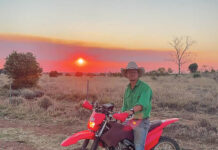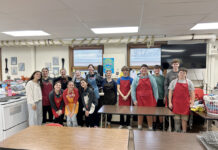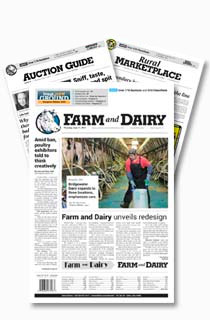
ALLIANCE, Ohio — Barns have long stood as iconic markers of Ohio’s agricultural tradition, officially recognized as a state symbol in 2019. But they’ve always attracted keen-eyed admirers who study their craftsmanship with the same fervor that storm chasers reserve for swirling skies.
That passion was on full display during the Friends of Ohio Barns Stark County bus tour on April 25, where those in attendance bookmarked observations to discuss during the organization’s all-day conference held the following day. Attendees visited five historic timber-framed barns, each revealing secrets the group eagerly uncovered with the same curiosity as forensic scientists.
Labor of love
The first stop was Jim Huston’s barn in Marlboro Township, Ohio, a meticulously preserved 1883 bank barn with double drive bays built by Civil War veteran James Madison Walker. Huston has spent decades carefully restoring everything from the stone walls to the original splined floors using locally sourced materials.
“Mom sold the place in ‘66, and we got it back in ‘95. And ever since then, I’ve been shoveling money into it,” Huston told the group that gathered to hear about his preservation efforts. “So that’s about it. I got it to where it’s not falling down. I still have a long way to go.”
Since purchasing the farm where he had spent many of his teen years — his and his brothers’ signatures still mark the wide boards of the barn’s waste wall from the 1960s — Huston and his wife Deb have been steadily working on renovations.
Visitors marveled at original hand-hewn elements (if you’re ever playing barn bingo with this group, you’ll want “hand-hewn” on your board) and careful reconstructions, like the vented doors Huston rebuilt using old patterns and window sashes found in antique shops.
“Everything else I had to make, which was time and labor-intensive,” he noted. All the repairs were carefully executed by Huston himself.
In transforming the lower level from dairy structures into horse stalls, he jacked up the basement, poured new concrete plinths to support the posts and added X-braces to reinforce the floor beams. After repairing the exterior stone walls, he rebuilt the large window openings and vented louvers, sourcing materials locally, often from dismantled barns.
As the group moved through the barn, deeper architectural details were revealed: hand-sawn beams showing marks from post-Civil War steam-powered mills, scaffold ties once used for temporary platforms and a rare hay trolley system — a marvel of 19th-century innovation that left observers in awe.
“We’re not just reading about history. We’re not just hearing about history. We are experiencing it firsthand,” Rudy Christian, founding member and past president of Friends of Ohio Barns, reminded the crowd. Unlike other historic buildings, barns evolved with the technological advances and needs of each farmer, and each remains as individual as the people who built and used them.
Other stops
Subsequent stops included the Schmuck Family Farm in Nimishillen Township, Ohio, once owned by John Mordie, an immigrant from Sweden who arrived in 1892.
Mordie built a cheese empire, owning 80 small cheese plants that contributed to his wealth. His gambrel roof barn showcased intricate architectural details, from its crown jewels, the copper cupolas, high up on the roof, to a unique grain storage system and hints of past innovations that spoke volumes about the farming methods it was built to enhance.
The group also visited the Scheetz barn in Louisville, Ohio, a 45-by-85-foot German bank barn. With its sturdy timber framing and unique characteristics, it was a highlight of the day, followed by a stop at the Brumbaugh Nature Center to see a large, well-preserved bank barn that showcased remarkable craftsmanship from wide boards to a double purlin roof and a rare waste wall design.
Lively discussions about the barns’ construction techniques abounded. Many tour goers were fascinated by the mechanics behind how workers managed to build the heavy timber structures without the modern machinery available today. They pointed flashlights at the various points of interest above them like tourists assessing Michelangelo’s famous ceiling fresco in the Sistine Chapel.
One of the group’s stops took them to White Star Farms in Osnaburg Township, Ohio, to see a Queen Rod Truss barn boasting a wing with a striking Gothic roof frame that resembles the inverted keel of a ship.
“My favorite thing is when you open the doors, every one of them is constructed differently. They were always built for function first,” Caleb Miller, president of Friends of Ohio Barns, told Farm and Dairy. Stepping inside the barn reveals how builders carefully designed each structure to meet the specific needs of the farmer it belonged to, drawing on skills and techniques passed down through generations, he said. “And so the beauty is in the function.”

he holds a land grant deed signed by Thomas Jefferson. (Paul Rowley photo)
Mike Schmuck, whose family has farmed the land for six generations, shared the barn’s rich history with the group. His great-grandfather, Reason Andrew Schmuck, who came from Wooster, Ohio, built the house and barn in the 1880s which today houses dry cows and dairy heifer replacements.
“It’s an honor for me to live in that house. It’s not just a place. It’s the family’s. And I’m just lucky enough to live here,” he said.
Schmuck has a keen eye for preserving his family’s legacy. He’s safeguarded many treasures that were tucked away, including old trade catalogs, farming equipment books and 1910s newspaper clippings. One of his most treasured finds is a land grant deed signed by Thomas Jefferson. But Schmuck’s favorite discoveries were the boxes of 35mm slides from the attic, offering a glimpse into his aunts’, uncles’ and father’s childhood on the farm.
Barn tour attendee Keith Thompson, a model maker who has been constructing scale models of barns for over 35 years, shared his deep appreciation for the craftsmanship behind these historic structures dating back to his childhood.
“I grew up on a dairy, sheep and pig farm,” Thompson told Farm and Dairy. “(I’ve made) over 1,200 — well, coming up close to 1,300 pieces”
That includes at least one the group had just seen: the barn at White Star Farms.
“I built that barn — scale model,” he said.
Thompson said that he finds joy in their intricate designs, particularly the oldest barns, which were built without the modern machinery that we now take for granted.
“The barns we’re seeing today were built before we had all the tools to make the job easier,” he said.”
For Thompson, each stop on the tour felt like a reunion with old friends. Building models is his way of honoring them.
“It’s just a joy,” he said.









